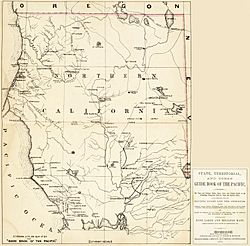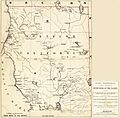Bald Hills War facts for kids
Quick facts for kids Bald Hills War |
|||||||
|---|---|---|---|---|---|---|---|
| Part of the American Indian Wars | |||||||
 Map of Northwestern California, ca. 1866, showing the Theatre of the Bald Hills War with a number of forts that figured in the fighting. |
|||||||
|
|||||||
| Belligerents | |||||||
| Whilkut - "Wintoons" Chilula - "Redwoods" Hupa "Mountain tribes" Chimariko Lassik Mattole Nongatl Sinkyone Tsnungwe Wailaki |
|||||||
| Commanders and leaders | |||||||
| Lassic-Wailaki + Say-Winne Claw-Foot Tsewenaldin John-Hupa Big Jim-Hupa |
|||||||
| Strength | |||||||
| 1858-59 1859-1861 May, 1859- Jan. 1860 Hydesville Volunteer Company 1860 1861 1861-1862 1862-1865 1863-65 1864 |
Whilkut 250-350 (1858 est.) Hupa 200 (1856 est.) |
||||||
The Bald Hills War was a conflict that took place in Northern California from 1858 to 1864. It was part of the larger American Indian Wars. The war involved the California Militia, California Volunteers, and the United States Army. They fought against several Native American groups. These groups included the Chilula, Lassik, Hupa, Mattole, Nongatl, Sinkyone, Tsnungwe, Wailaki, Whilkut, and Wiyot.
The fighting happened across several counties in Northern California. These were Mendocino, Trinity, Humboldt, Klamath, and Del Norte. During the American Civil War, the Humboldt Military District was created in 1861. Its main goal was to manage the fight against the Native American people in these areas. The district's headquarters was at Fort Humboldt in Eureka, California.
Contents
Why the War Started
Several reasons led to the Bald Hills War. A major cause was the impact of settlers' activities on the Native Americans' food supply. Commercial hunting of deer and elk for their hides reduced game. Settlers' cattle and pigs ate or destroyed important native food plants like acorns.
The Native American tribes in the Bald Hills area relied on hunting and gathering for their food. This way of life was greatly disturbed after the Klamath and Salmon River War in 1855. More and more settlers traveled through their lands, causing even more problems.
From 1856 onwards, settlers took over thousands of acres of Native American land. They used it to grow crops like wheat and potatoes, and to raise cattle and pigs. These farms appeared quickly in areas that were wilderness just a few years before. The lumber industry also grew, with many sawmills operating by 1856. Farmers and ranchers in Humboldt County sold their goods to miners in other counties. They moved their products and animals along trails through the Bald Hills.
For the Whilkut people, the arrival of settlers and the loss of their traditional food sources caused anger. They wanted to drive the settlers away. After a harsh winter in 1857, the food crisis became very serious in 1858. Small incidents happened between February and June 1858. The war officially began when a packer named William E. Ross was killed on June 23, 1858.
Early Conflicts and the "Wintoon War"
The war started with clashes between the Whilkut people, also called "Wintoons" by settlers, and settlers or travelers. These conflicts happened on the trails between Humboldt County and Trinity County. In July 1858, volunteer groups were formed to fight the Native Americans.
In late August 1858, people in the towns of Union and Eureka pushed for official volunteer companies. They also raised money to pay for them. Public meetings were held to discuss how to protect people and property during the war with the Whilkut.
On September 5, 1858, Governor John B. Weller was told that Native Americans had killed several people. They had also caused problems on the road from Weaverville to Humboldt Bay. Travel on this route became very dangerous. The Governor was asked for military help to open the road and protect travelers.
Governor Weller asked Adjutant General William C. Kibbe to go to Weaverville. He was to report on the situation, find out how many Native Americans were there, and what attacks had happened. If travel was still unsafe, Kibbe was to form a volunteer militia company. This company would stop the attacks and keep the important road open.
William C. Kibbe appointed Isaac G. Messec as Captain of a new California Militia company, the Trinity Rangers. Messec led this group in the Klamath & Humboldt Expedition against the Whilkut in late 1858 and early 1859. The fighting was not decisive, and harsh winter weather ended the "Wintoon War." The Whilkut, facing starvation, were forced to surrender. They were moved to the Mendocino Indian Reservation near Fort Bragg.
Even though the Wintoon War ended, the reasons for conflict spread. The fighting moved to the Chilula people and southward to the Eel River Athapaskan peoples and the Mattole in the Mattole River and Bear River Valleys. Also, many Whilkut gradually returned to their lands. The U.S. Army set up Fort Gaston among the Hupa people on the Trinity River. They also built posts in the Eel River valley to try and keep peace. However, federal troops struggled to fully protect settlers from Native American raids. Settlers living far apart in the countryside found it hard to defend themselves.
Local Efforts and the Wiyot Massacre
After a local rancher was killed while trying to get his cattle back, the Hydesville Volunteer Company was formed in mid-1859. However, this group was never officially approved or funded by the state. It broke up in January 1860 when local money ran out. Local areas could not afford to keep a militia, and the state felt it was the federal government's job.
Trying again, settlers in the Eel River area formed the Humboldt Volunteers in early February 1860. But on February 26, 1860, some settlers attacked peaceful Wiyot people living near Humboldt Bay. This included the terrible Indian Island Massacre. Some members of the Humboldt Volunteers were involved in these killings. Even though they were never charged, the unit was disbanded in late 1860. Between 1860 and 1862, many settlers in the remote areas had to leave their farms. They moved to safer settlements along the coast.
California Volunteers Join the Fight
In late 1861, federal troops were called back east to fight in the American Civil War. California Volunteer Regiments were formed to replace them. These troops were sent to the new Humboldt Military District under Colonel Francis J. Lippitt. They set up several posts to protect settlers.
At first, the troops, who were not used to the rough conditions of the Northwest, struggled to defeat the Native American groups. However, continuous patrols eventually showed results. Lassic and his group surrendered on July 31, 1862, at Fort Baker. More warriors surrendered later. A total of 212 captured Native Americans at Fort Baker were sent to Fort Humboldt. They joined 462 others and were held in a temporary prison on the Samoa Peninsula in Humboldt Bay.
In September, 834 of these prisoners were sent by steamship to the Smith River Reservation. This reservation was north of Crescent City. Fort Lincoln was built nearby to guard the reservation and keep the Native Americans there. It seemed like the war was being won.
However, in early October, Lassic and three hundred Native Americans, mostly warriors, escaped from the Smith River Reservation. More Native Americans left the reservation throughout November. The situation was back to how it was before Lippitt's campaign began.
The Two Years' War
The conflict finally ended during 1863 and 1864, a period known as the Two Years' War. Colonel Lippitt was replaced on July 13, 1863, by Lieutenant Colonel Stephen Girard Whipple. Whipple was a former Indian agent, local politician, and newspaper editor. He believed in a more aggressive approach to the war. He wanted to use men from the local settlers who were used to fighting in the redwood forests and Bald Hills.
Under Whipple's command of the Humboldt District, a more active campaign began. All California Volunteer units carried out constant patrolling and skirmishes. Henry M. Black took over for a few months while Whipple served in the Assembly. Black continued the operations, which led to many Native Americans being killed or captured.
Whipple's efforts finally forced most of the tribes to make peace in August 1864. However, some operations continued into late 1864 before all fighting stopped. California Volunteers remained in local forts until they were released from duty after the Civil War ended in 1865.
Images for kids


